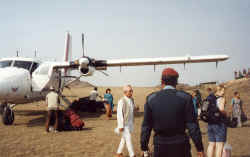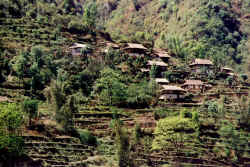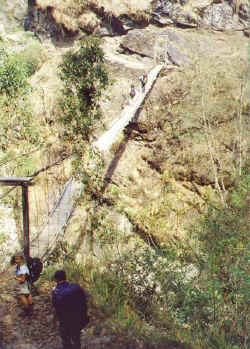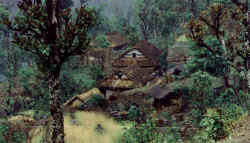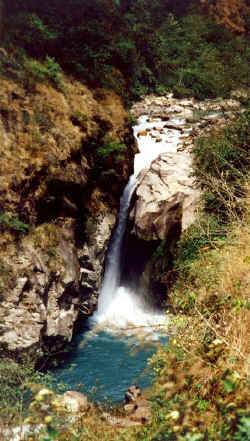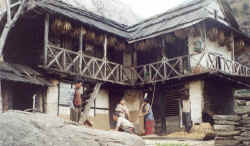MyHimalayasimpressions from |
|
|||||||
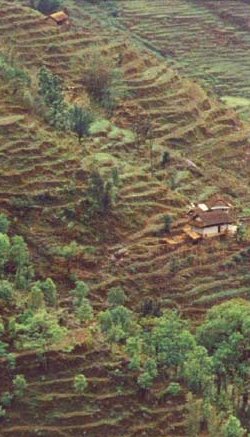
Suketar airstrip could be called exposed, the runway is wide and long, but steep drops are on each side.
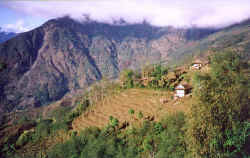
Terraces and typical Rai houses are the first highlights after half a day of
walking.
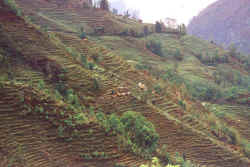
Terraced fields along the Tamur river let you forget you are close to the 3rd
hightest peak on earth.
Hamlets on the hillsides, forests, waterfalls - what a relief after busy chaotic Kathmandu.
Swaying bridges; an exciting way that saves us from further ups and downs.
Typical Rai village with neatly arranged houses that are surrounded by wheat and fice fields.
Waterfalls, creeks and a variety of plants make for an interesting walk
Kangchenjunga: Kathmandu - Biretnagar - Sekathum
Kathmandu - Biretnagar - Suketar - Sekathum
28th March 2001: Kathmandu - Biretnagar
Since my arrival in Kathmandu two days earlier I was busy visiting friends. Usually I am itching to get out of the city, this time I wouldn't mind staying a little longer.
Getting to the starting point of the trek on roads is often the most strenuous part of the whole adventure. Luckily we skip the 40-hour bus drive and take domestic flights instead. First a small airplane to Biretnagar, second-largest city in Nepal, from there to Taplejung. Traffic jam between Boudha and Thamel makes me a bit nervous, usually flights are delayed but I wouldn't have been surprised if the first ever punctual flight out of KTM had happened while I sat in the taxi miles away from the airport. Luckily I get a few minutes too early to Thamel and have enough time to drop off my stuff at the Hotel Utse and make reservations for the few days I am alone after the trek.
After buying some essential snacks (note for next time: buy packaged cheese) I hop on the bus that leaves for the airport. The chaos on the roads and in the domestic airport is smaller than usual, indicating off-season. Everything goes very smoothly and almost on time we squeeze in the tiny seats of the Twin Otter.
Due to haze no mountains appear on the left side. The terraces on the hills below are very dry and dominated by tones of brown and red. Last winter was droughty and everybody is hoping for rain since the rice harvest will be in danger otherwise.
As we approach Biretnagar, the hills become flatter and eventually give way to an endless plain covered by wide fields in different colors. Groups of straw huts are built among fields with little roads connecting them. The basis and rhythm of life is still the same for the majority of the 20 million Nepalis. Western ideas and products are also penetrating into their lives but this does not lead to fundamental changes yet.
Biretnagar is a large town near the Indian border. Brick and concrete houses and shops follow the few main roads, further out the farms become more numerous. It is an odd mix of 1960's 'modernity' and congenial shabbiness. A jeep takes us from the airport to the town's best hotel. The atmosphere is relaxed but since there is not much to see I keep my walk pretty short. Haze makes the heat bearable, though it is still very hot compared to Kathmandu, even more so after the cold spring temperatures in Switzerland.
The Hotel 'Eastern View' has good fans and comfortable beds: I finally catch up on some sleep that I lost while preparing the trip 4 days before it started. To begin trekking with fatigue is definitely not recommended. The delicious Indian dinner blows me away. I overeat on vegetable curries, naans, papadams and rice; my full stomach and the heat makes it difficult to fall asleep.
So far I did not get to know the other trekkers well; I stayed in Boudha and only met them once for a short dinner. I share a room with John, a quiet investment banker from Chicago.
Joel Schoene is leading the trek. He's a friend of Jamie's and equally addicted to the Himalayas though more specialized in Ladakh and not a fan of climbing. He's easygoing and more of an organizer than a tough leader, which suits me fine.
Dave Haun, a cave-explorer from the US, was in the area two years earlier and came back to explore a pass into Tibet. He's a really nice guy. Eric is another cave-explorer, very funny character. It is his first time in Nepal but more culturally aware respectful than some 'second-timers'. Emma from England is about my age. Bonny has been travelling for the last few years. Nicole from France speaks a little Tibetan and despite being very greedy when it comes to chocolate cookies, is a lot of fun. Cynthia is a part-time photographer from Canada. Lucy is from Washington, DC. The oldest of the group is Rein, a retired space engineer who enjoys travelling and is in very good shape.
Everybody seems nice, though my guess is that life-lasting bonds of friendship will probably not be tied on this trek.
Biretnagar - Suketar - Jogidanda (Day 2)
A second flight will take us further north where the valleys lead to the mountains. Even though it is still early morning when we take off, haze is already in the air and hides the mountains in the northwest where even Makalu (8'481 m) can be seen on clear days.
The rivers from the mountains are nearly dried out. It is arid; the first small hills are so barren that they might well be in the Sahara. The hills get larger, after half an hour the pilot aims at the top of a nearby hill with steep drops on each side. On the saddle is Suketar airport! Compared to other STOLs (Short Take Off and Landing), it is quite long and wide, thus landing does not seem as breakneck as in other places. A few meters after the sheer drop the pilot sets the plane down, and stops near the gate.
The views over the the hills and a nice breeze of mountain air make me realize how much I missed the experience of trekking.
People have lined up along the fence, most of them are bored locals but then I spot our crew. Bagman worked as a kitchen boy on the last Manaslu tour and seems sincerely happy to see me. I feel the same. The loads are carried to a nearby guesthouse and the Sirdar Ram Kaji organizes the reshuffling of the loads. This usually takes an hour or two, in the meantime I walk around town. There is not much to see, but I am surprised to find a Buddhist gompa so far south and speak to an old Sherpa woman who speaks proper Tibetan and has a key for the main door. The monastery is well-kept, but is not used very often and does not contain anything exceptional.
While we enjoy drinks and biscuits the sound of a small airplane can be heard, instead of landing it circles once above the airstrip but then it does arrive. It's a chartered tourist flight from Kathmandu, the other group is not happy to see us since they wanted to trek 'all alone'. Their direct flight from Kathmandu yesterday was not allowed to land, because the locals were very upset that they are not offered good flight connections therefore they blocked the airstrip and the tourists had to return to Kathmandu. The same thing would have happened today if Yeti Airways hadn't made some concessions.
After lunch we start our easy half-day walk to the campsite. The wide trail goes slightly down into a wide valley covered by forests and terraces and dozens of small hamlets. The beautiful houses of the Rai people are built in small groups, their appearance is a similar to the ones in central Nepal but the Rai houses are much neater: two or three stories high with a thatched roof and a small wooden balcony, the walls are plastered and painted orange and white. Everything is arranged very neatly and often symbols are painted on the outside. The kitchen is on the ground floor in the largest room with an open fireplace and a wooden cupboard with shining plates, cups and cooking utensils. This room is also used as a living room, especially when temperatures are colder. Above the living room are the sleeping quarters. Animals, mainly goats, are kept in a separate building where the fodder is stored. People live largely self-sufficient on the rice and corn they grow on their fields. Oranges, bananas and apples are a welcome side dish, the trees offer welcome shade around the house. Those who can afford keep goats, pigs and chickens in small numbers. During the day the oldest child watches the house while the rest of the family is out with the goats or works in the fields. We do not meet many people.
The Rai and Limbu culture is different from the Hindu and Buddhist culture, but it is hard to find books about it. I assume that they face similar problems like the Lepchas in Sikkim, who are the indigenous people but are threatened to be marginalized by the two other predominant cultures, especially Hinduism. To my surprise some Sherpa families have also moved down to the middle hills.
It is a nice walk on ridges and through forests with some small creeks coming from higher up. It is partly cloudy and no mountains are visible at the horizon, but everybody enjoys the stroll in the warm sunshine, happy to be so far away from the chaos in Kathmandu and the heat in Biretnagar.
In the afternoon we reach Jogidanda where we camp near the school. 10 teachers take care of 500 young students, many of whom went back home already but some are still playing while we put up the tents. The American group has fled (either because of us or because of the kids who crowd around the tents) and chose another campground, The kids are well behaved and speak good English, an interesting conversation starts. Some of the kids even understand my simple Tibetan. It is also an example of the harmony between Nepal's different cultures and people; some of them are Rai, some Sherpas, some Gurung, and though they are aware of 'who is who' it is not a barrier. This 'harmony' is often propagated by the ruling elite (mainly Brahmins and Chettris) who call every demand for more autonomy or de-centralization disrespectfully 'communal'. It is the high castes who often use their superior status in an unfair way to keep their material wealth and social status.
The Maoists partly explain their success with the autonomy they give to local people. Whether that is the leadership's genuine interest or just a lure is hard to say. Somehow it sounds like Mao's speeches 50 years ago, as soon as securely in power the only culture tolerated was the doctrine of the Communist Party.
Western Nepal is probably the most neglected region and gets little attention from the government in Kathmandu. No wonder that's where the insurgency started and was so 'successful' after four years that the area was in effect governed by the Maoists. Though they are active in almost all parts of the country, Central and Eastern Nepal are safe. Since tourists were never attacked, you could probably also trek in Western Nepal and only risk of being asked for 'donations', or bandits posing as Maoists will steal your camera. During this trek I do not see any sign of Maoist activity.
Dinner is enjoyable though I still feel full after yesterday's Indian meal. But calories burn quickly while trekking, so I don't worry.
Jogidanda - Chirwa (Day 3)
Somebody started packing way before the agreed time which caused a chain-reaction: the kitchen was confused, porters were suddenly waiting for everybody to get up. It is quite hot by the time we are ready to leave after a rich breakfast. It takes some days to get into the routine of organizing yourself in the morning, the kitchen crew probably has the same problem.
Creeks flows down the sidevalleys which we cross on wooden bridges. Despite the dry heat the forests are very lush. Cardamom that grows between the trees is the only cash crop of the middle hills; it is harvested in autumn and sold in market places further south where it sells for $5 per kilo and is used as medicine, spice and natural sweetener. As soon as we get out of the forest's shade the fields are very barren. The Rai houses become more picturesque, ornaments are painted on its walls, rails are painted black and white, and corn is laid over bamboo frames for drying. At the entrance of a village we walk beneath a 'gate' with green branches atop, maybe that's the lowland version of the chortens we will encounter further north in the Buddhist settlements.
The descents and ascents after lunch are a good opportunity to get in shape. We walk mostly high above the river, enjoying the fresh smell of plants and the views down the hillside where green wheat sprouts on the terraced fields. Plank suspension bridges in decent conditions take us over the sidevalleys, reducing the up's and down's considerably. The valley is getting more and more narrow, the flanks become too steep for agriculture and at the end of the day we walk close to the river. Our second camp lies between wheat fields and the Tamur river. Chirwa does not have the charm of the Rai hamlets, partly because its location between huge boulders at the valley floor, but mainly because it is a bit shabby and the people are not as friendly as before. Luckily the campsite lies ten minutes after the village, we escape 'civilization' and enjoy the evening on the quiet place where the roaring of the river is the only 'disturbance'. Dark clouds prevent me from swimming, as soon as we start dinner a heavy storm hits the valley. For the next ten minutes we are busy securing the tents and digging trenches around them. Although the lightning lasts for awhile longer, the downpour becomes less strong and almost stops when we go to bed.
As usually I am in bed early, read for half an hour before falling asleep, and wake up 10 hours later shortly before bed-tea around 630. That is, after getting used to howling dogs, roaring rivers or roosters.
Chirwa- Sekathum (Day 4)
Before the arrival of morning tea the chirping birds wake me and I open the tent: it is a beautiful clear and cool morning. During the night all clouds disappeared. The storm appears to have polished everything in sight; the sky is cloudless, dust was washed off the trees, even the grass seems greener. These first moments of the day are always great, lying and dozing in the sleeping bag you get to enjoy the smells and sounds (and with a little extra effort even sights) of the Himalayas.
After morning tea arrives we start packing. The porters usually leave while we are having breakfast. Often we will catch up with them two hours later when they are having their early lunch (or late breakfast): a huge pile of rice with lentils, and potatoes or other vegetables, if available. While we are having our lunch at noon, they pass us, we'll arrive in camp at about the same time.
The walk in the forest is very pleasant, the temperatures in the shade are perfect and the refreshing smell is invigorating. The trail follows the river and is less strenuous than yesterday. Cardamom groves are in the forest, wheat was planted recently on the hillside and everything seems nicer than yesterday. The flat valley near Tapethok must look even more idyllic in autumn's harvest season: young birch trees grow next to large black boulders; slightly terraced fields stretch to the foot of hills where the terraces continue. The surrounding hillsides look like steps of an amphitheater with neat houses and patches of forest on its steps.
The scenery remains the same for the rest of the morning. The kitchen crew overtook us and has already set up their stoves when we arrive after three hours of easy walking. I take a refreshing shower in a nearby rivulet and doze until lunch is ready. For the first time I feel really hungry and look forward to the meal.
The sun shines fiercely, luckily I brought my umbrella that will prove to be a great thing to have. Some group members see trekking as an opportunity for sunbathing, in addition to walking in unacceptable clothes they lie half-naked in the sun. Well, I guess as long as Joel does not complain I am not entitled to say anything.
Despite the umbrella it is too hot for a nap and I am off soon after dessert. The bridge over the creek in Tamewa is swaying more than usual and quite a few planks are missing. Since the water level is low I prefer jumping across on some stones. Some climbs in the hot afternoon sun take us high above the river, it is dry and dusty as if no storm had passed during the night. Lizards on the stones are the only animals I see, usually birds and butterflies make walking more interesting. Some colorful flowers grow in the shade of huge ferns, far down the green Tamur river roars.
Our camping spot is at the entrance to one of the side valleys in the east. High above us on the other side stands a long line of prayerflags that go up to a Buddhist monastery. We cross the first sidevalley on a suspension bridge, after another climb in the sun we enter forest again. Below is the Ghunsa Khola river that has its source in the Kangchenjunga glaciers. Sekathum lies on a plateau above the junction of the two rivers, two large campsites are further down on each side of the bridge. I find a nice spot near the river where boulders form a little pool and take a very, very refreshing bath. At first the body feels numb, after ten seconds it is bearable and eventually pleasant. My dislike for frigid water seems to wane with every trekking. I do laundry, take another short bath and sit in the hot sun to get dry. I enjoy 'bathing' in the Himalayas, not because I am paranoid of smell, I just love water. Some friends at home call me 'the human fish'.
The wide lawn is a nice campsite, our crew stays in the teahouse, or tongba-house to be more exact. Tongba is a popular alcoholic beverage made out of fermented millet that is put in a large wooden vessel, hot water is added and the alcoholic mixture is sucked out with a straw to keeps the millet at the bottom. It is quite mild and tastes nice, a little bitter, though more impressive than the actual drink are the 'cups': often they look like miniature wooden barrels with a polished brass banding, the straw is made of bamboo. 'Tongba' is also the Tibetan word for 'empty', maybe this is how the drink got its name since hot water refills are free and when it's empty people might have said: 'Tongba ray, lu-ro-nang'. (It's empty, please fill it up.) Admittedly, this is just my own theory.
The kitchen crew prepares dinner in the adjacent room. So far they have mostly kept to themselves, Bagman has developed some very polite and funny ways of staying away from tourists he doesn't like. Mege is a good cook, his food is not as delicious as Tenba's but nobody will get sick during the next few weeks, which is quite an achievement. Bagman does some work in the kitchen, serves the food and also works as assistant Sherpa during the day. His English has improved a lot since our Manaslu trek and he seems to be a good allrounder - he's also worked as cook on climbing expeditions before.
Punctually like yesterday the storm arrives, but is less strong and seems to move over us. As long as it rains only at night I am happy about it, maybe I will get the experience the lush beautiful scenery on the way down, including the blooming rhododendron forest that we missed so far.
|
Summary Part 1:
Getting to the east of Nepal takes 40 hours by bus; or two comfortable domestic flights. First we fly to Biretnagar, a city near the Indian border. The next day we take another small Twin Otter to get to Suketar, a small airstrip in the low hills. Just a few dozen miles south of the towers of eternal ice, but still quite a different world. Dense forests and rice terraces cover the gentle hillsides which will become steeper and more barren during our hike towards the mountains. The people in the hills are Rai and Limbu and mainly live on agriculture and a little husbandry. The small hamlets are spread over the hills, if it weren't for the white and orange houses the terraced hillsides would look like a gigantic natural green pyramid. |
